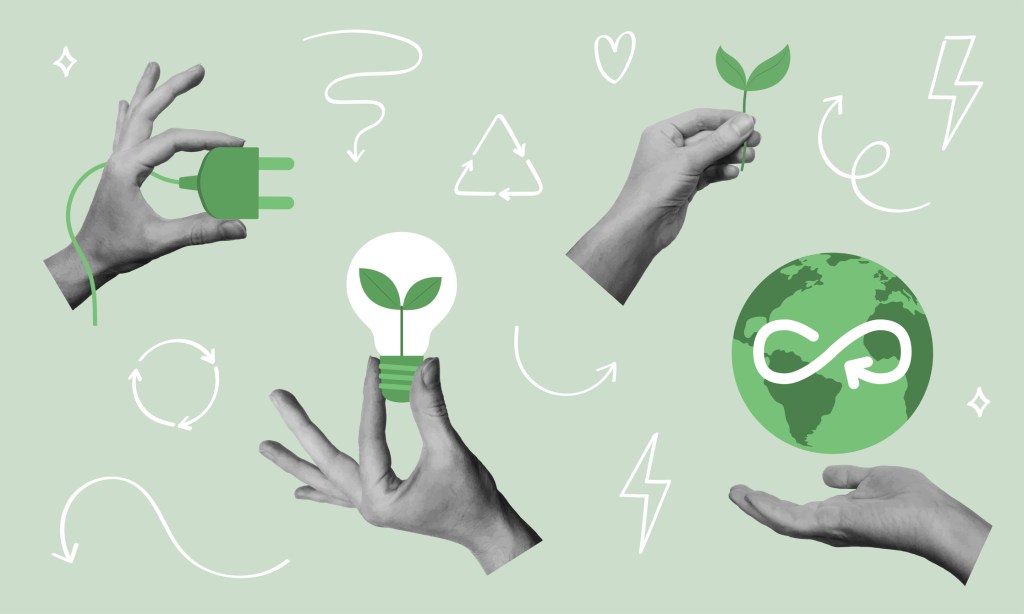Growing up, many of us were instilled with some basic principles for not wasting Earth’s resources — don’t run the water while brushing your teeth, recycle your aluminum cans, use cloth napkins rather than paper. But as we hear more and more about the changing climate, it might feel like those habits aren’t making enough of an impact.
Thankfully, there are a wealth of ways to make other sustainable (in both senses of the word) changes in your day-to-day life. They range from the mindsets we cultivate to the products we buy. Keep reading for some helpful guidance.
5 Overall Adjustments

Educate Yourself
It’s difficult to stick with change without knowing exactly why you’re doing it. Sure, we all want to be environmentally conscious — especially given recent studies suggesting it makes us more appealing in the romantic realm — but if you don’t have a meaningful connection to your actions, they’re liable to eventually fall by the wayside.
Educating yourself can take the form of volunteering with organizations working to protect the environment, enrolling in community college classes on climate change, and consuming media (books, documentaries, podcasts) that offer insight on these topics.
Start Small
Committing to becoming more eco-conscious doesn’t mean bearing the burden of saving the planet entirely by yourself — every single positive change you make counts for something.
“It’s easy to feel like one person in a sea of billions. But every plastic bottle of the thousands in the ocean was thrown there by someone who thought that way. Instead, do what you can, and try to influence the people around you to do what they can,” cookbook author and chef Robin Asbell told HuffPost.
The more frequently you reach for the cloth towel, remember to bring your reusable bags to the grocery store, or opt to buy secondhand, the better.
Take Timing Into Account
A lot of eco-friendly choices require more time. For instance, riding the bus or hoofing it is probably going to take longer than hopping in your car. The energy-efficient dishwasher cycle can run for up to three hours, while the one-hour wash cycle is staring you down in the morning. Making a shift requires forethought and planning, just like with any habit.
Make Swaps Enjoyable
Also just like any habit, the more enjoyable it is, the more likely you are to keep it up. You can apply this to any number of eco-friendly actions based on how you frame things. Walking to the grocery store or post office is a chance to listen to music or a podcast and take in the fresh air. Splurging on the cute fabric napkins or kitchen towels might be worth it if it means you’ll be more inclined to use them instead of paper products.
Don’t Leave Your Habits at Home
Studies have found that people tend to be less green while traveling than they are in their daily lives. In a piece for The Conversation, Lorraine Whitmarsh, a professor of environmental psychology at the University of Bath, and Nicole Koenig-Lewis, a marketing professor at Cardiff University, explained this may be due to a variety of factors, including the human tendency to focus more on enjoyment and less on obligations when we’re on vacation. It may also just be harder to continue habits in different contexts and in environments we don’t control.
Understanding this allows us to prepare better and be more intentional about our choices when we travel. That can start with where you lodge. Booking.com has a filter for finding sustainable digs, with a specific set of criteria establishments must meet to fit the bill. You can also search for planet-friendly stays on platforms like Regenerative Travel and EcoHotels. If you book directly, look at the establishment’s website; many include details of their efforts to be energy-efficient and reduce waste.
More suggestions on how to stay green on vacation.
5 Basic Eco-Friendly Tips

Use Apps That Track and Help Offset Your Carbon Footprint
There are multiple apps that track your carbon footprint and then help you offset it through donations to science-based climate projects, carbon capture initiatives, and conservation efforts. Many also assist you in staying on top of your choices and making better ones.
Swap Out Single-Use Plastics
I recently found these great mesh bags for produce. My relief at no longer having to toss 5-10 bags every week is palpable. Purchasing shampoo, conditioner, and hand soap in bulk and storing them in reusable containers helps cut down on the huge amount of plastic thrown away every year. Consider pledging to only buy plastic water bottles in a bind and instead bring your own refillable jug along whenever you leave the house.
Look Into Energy-Saving Home Improvements
From using energy-efficient light bulbs to investing in double-paned window glass and even upgrading some of your appliances or switching to solar, your home may be a perfect place to begin implementing change. Get more ideas here.
Opt for Used or Free Items
You don’t have to hit up thrift stores every weekend to start shopping secondhand (but who doesn’t love a Goodwill haul?). Poshmark, eBay, Facebook Marketplace, and Buy Nothing groups are all wonderful resources for clothing, books, games, toys, furniture, decor, dishes, and more. You can even find certain items used on Amazon.
Be Mindful in the Kitchen
Food waste is a massive issue, but you can do your part in a number of ways: composting, meal planning to ensure you don’t end up with spoiled produce, eating meat more mindfully, and buying ethically sourced items, to name a few. Learn your FoodPrint for a better idea of how what you consume affects the planet.











